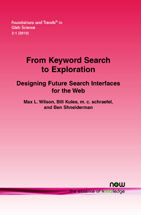From Keyword Search to Exploration: Designing Future Search Interfaces for the Web
By Max L. Wilson, Intelligence, Agents, Multimedia (IAM) Group, School of Electronics and Computer Science, University of Southampton, UK, mlw05r@ecs.soton.ac.uk | Bill Kules, School of Library and Information Science, The Catholic University of America, USA, kules@cua.edu | m. c. schraefel, Intelligence, Agents, Multimedia (IAM) Group, School of Electronics and Computer Science, University of Southampton, UK, mc+ft@ecs.soton.ac.uk | Ben Shneiderman, Department of Computer Science and Human-Computer Interaction Laboratory, University of Maryland at College Park, ben@cs.umd.edu
Abstract
This monograph is directed at researchers and developers who are designing the next generation of web search user interfaces, by focusing on the techniques and visualizations that allow users to interact with and have control over their findings. Search is one of the keys to the Web's success. The elegant way in which search results are returned has been well researched and is usually remarkably effective. However, the body of work produced by decades of research into information retrieval continues to grow rapidly and so it has become hard to synthesize the current state-of-the-art to produce a search interface that is both highly functional, but not cluttered and distracting. Further, recent work has shown that there is substantial room for improving the support provided to users who are exhibiting more exploratory forms of search, including when users may need to learn, discover, and understand novel or complex topics. Overall, there is a recognized need for search systems to provide effective user experiences that do more than simply return results.
With the aim of producing more effective search interfaces, human computer interaction researchers and web designers have been developing novel interactions and features that enable users to conveniently visualize, parse, manipulate, and organize their Web search results. For instance, while a simple set of results may produce specific information (e.g., the capital of Peru), other methods may let users see and explore the contexts of their requests for information (more about the country, city, and nearby attractions), or the properties that associate groups of information assets (grouping hotels, restaurants, and attractions by their type, district, or price). Other techniques support information-seeking processes that may last weeks or months or may even require collaboration between multiple searchers. The choice of relevant result visualization strategies in new search systems should reflect the searchers and the higher-level information needs that motivate their searches. These examples provide further motivation for supporting designers, who are challenged to synthesize and understand the breadth of advances in search, so that they can determine the benefits of varied strategies and apply them appropriately to build better systems.
To support researchers and designers in synthesizing and understanding the advances in search, this monograph offers a structured means to think about web search result visualization, based on an inclusive model of search that integrates information retrieval, information seeking and a higher-level context of tasks and goals. We examine each of these levels of search in a survey of advances in browsers and related tools by defining search-related cognitive processes and analyzing innovative design approaches. We then discuss evaluations at each of these levels of search, presenting significant results and identifying both the traditional and novel means used to produce them. Based on this examination, we propose a taxonomy of search result visualization techniques that can be used to identify gaps for future research and as a reference for designers of next generation web search systems.
From Keyword Search to Exploration
Web search has already transformed the way people find travel information, cope with health problems, explore their family history, or discover their cultural heritage. The enterprising researchers and designers who strive to support the ever rising expectations are developing finer taxonomies of usages, richer cognitive models of information seeking, and more effective evaluation strategies. This carefully structured monograph reports on these efforts and the variety of interface innovations that surround novel visualizations of search results. It lays out the territory for researchers and designers who wish to support the growing number of users who are eager to explore freely and discover successfully.
